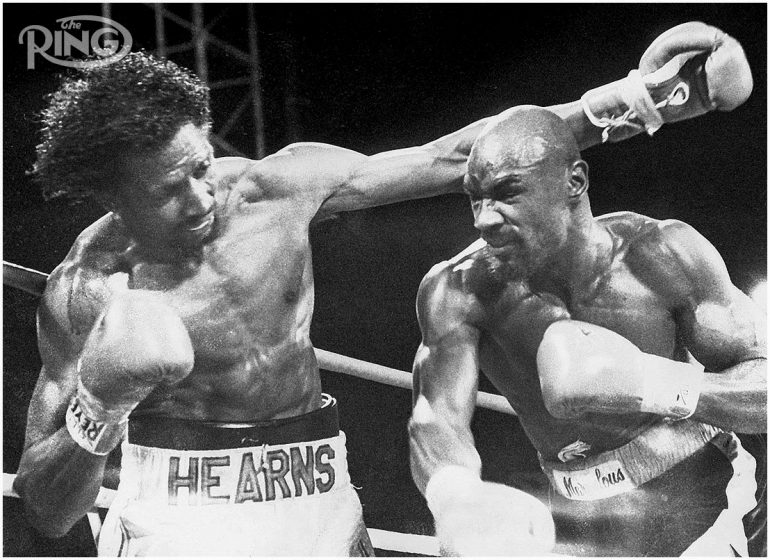Championship Rounds a must-read anthology for boxing fans

Championship Rounds, Round 2 is an anthology of boxing articles written by award-winning columnist and International Boxing Hall of Famer (Class of 2020) Bernard Fernandez, culled from his decades of work at the Philadelphia Daily News and as a contributor to The Ring, RingTV.com and other media outlets. An eclectic collection of stories, the book is a must-read for boxing fans, or anyone who appreciates excellent writing. Fernandez’s prose is all muscle, no fat; his spare yet elegant style reflects the subjects he writes about, which is to say that form matches function.
Round 2 opens with a riveting piece that is as rousing as the first round of Hagler-Hearns. Two aging and battered fighters, Aaron Pryor and Jerry Quarry, attempt to get boxing licenses in Wisconsin, the only state that might approve their bids to fight again. Pryor, 34, has a detached retina that’s as limp as the ropes in the “Rumble in the Jungle.” Quarry, 45, has a damaged everything, most notably his mind due to CTE. The decision to allow their respective bouts to go forward hinges on Wisconsin’s progressive statute that ensures equal access to people with disabilities.
 The story spells out the issues that will determine whether or not the impaired, well-past-their-prime boxers will be allowed to fight. The Pryor/Quarry saga sets high expectations for the 45 entries that follow, and the author meets those expectations glowingly. (Note: Pryor was granted permission to fight in Wisconsin and he knocked out a tomato can named Daryl Jones. Quarry’s application for a license was denied and he was dead eight years later.)
The story spells out the issues that will determine whether or not the impaired, well-past-their-prime boxers will be allowed to fight. The Pryor/Quarry saga sets high expectations for the 45 entries that follow, and the author meets those expectations glowingly. (Note: Pryor was granted permission to fight in Wisconsin and he knocked out a tomato can named Daryl Jones. Quarry’s application for a license was denied and he was dead eight years later.)
The rest of the anthology keeps pace. Fernandez ventures back into boxing history and gives rousing accounts of such notable champions as Floyd Patterson, Joe Frazier, Mike Tyson, Joey Giardello and Emile Griffith, one of my favorites. (Note: My father and I watched Griffith outpoint Nino Benvenuti in their second bout, with Don Dunphy calling the action. My father loved Griffith’s trainer, Gil Clancy, and we were pulling for Emile.)
There is the heartfelt tale of New Orleans fighter Joe “Old Bones” Brown, a champion, I am embarrassed to say, I never heard of until I read the book. “Old Bones” not only fought in the ring, but also in the Pacific during World War II, where he served in the Navy and participated in seven island invasions. Fernandez compares Brown’s style to Sugar Ray Robinson’s, but the story goes far deeper than mere boxing. It details the discrimination Brown faced in the Jim Crow South, where he was forced to fight for peanuts over a large chunk of his career on the so-called “Chitlin’ Circuit,” making for numerous roadblocks he was forced to clear on his way to becoming lightweight champion. Delayed though it might have been, Brown made the most of his tenure at the top, setting a division record with 11 title defenses, a record that stood until Roberto Duran came along. (Fernandez’s New Orleans upbringing pours through on this one.)
Along the way, there are similarly probing looks at a number of fighters familiar to the public such as Riddick Bowe, Tyson Fury, Earnie Shavers (the self-proclaimed hardest puncher in the game), Bobby Czyz, Oscar De La Hoya and even Eric “Butterbean” Esch, the “King of the Four-Rounders.” But the lineup also includes such significant supporting figures as Angelo Dundee, ring announcer Jimmy Lennon Jr., trainer/TV commentator Teddy Atlas and longtime Miami Herald sports columnist Edwin Pope.
The challenge in reviewing an anthology is choosing the stories to single out, those that are representative of the collection as a whole. This is especially true of Round 2, because each piece is worthy of its own praise. As a native Bostonian, I was particularly drawn to “Luck of the Non-Draw,” which appeared in The Ring’s Gatti-Ward special issue of August 2020.
Prior to the first Arturo Gatti-Micky Ward fight, the boxing world, for the most part, viewed “Irish” Micky as a journeyman, a tough guy who was game but not great. We in Boston viewed our Lowell, Mass., neighbor quite differently. We saw him as a talented fighter who simply needed an opportunity to prove he was more than that. The years passed and we began to wonder if Ward would ever get the chance to prove himself on a larger stage.
Fate intervened in the first fight with Gatti at Connecticut’s Mohegan Sun Arena, which was televised by HBO. It was a 10-round war that was voted The Ring’s Fight of the Year, Ward winning a slim majority decision. Fernandez points out that if the fight had been scored a draw – which easily could have happened – Gatti’s manager likely would have passed on a do-over, but Ward’s victory almost guaranteed a rapid rematch, the second act in what would further morph into a classic trilogy. Gatti won Part 2 as well as the finale, which was also named Fight of the Year by The Ring. All three fights went to the scorecards, but it was mere happenstance that the now-classic rivalry extended beyond the original bout.
Bernard Fernandez is a gift to the wondrous genre that is boxing writing. I highly recommend Championship Rounds, Round 2, which can be purchased through Amazon.com and other book-selling outlets.
Tom MacDonald is an adjunct professor of the Woods College of Advancing Studies at Boston College and author of the Dermot Sparkhawk mystery novels















